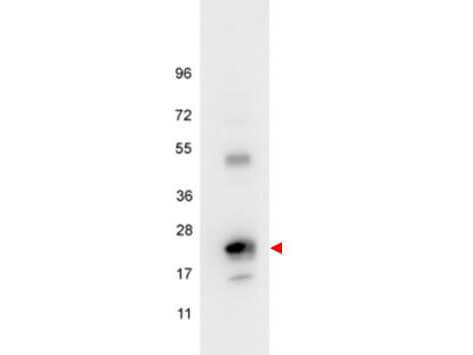Anti-Human IL-6 (RABBIT) Antibody
IL-6 Antibody
- SPECIFICATION
- CITATIONS
- PROTOCOLS
- BACKGROUND

| Host | Rabbit |
|---|---|
| Conjugate | Unconjugated |
| Target Species | Human |
| Reactivity | Human |
| Clonality | Polyclonal |
Application
| WB, IHC, E, I, LCI |
| Application Note | This purified antibody has been tested for use in IHC and western blotting. Reactivity is also expected in ELISA, neutralizations, radioimmunoassay and immunohistochemistry. The endotoxin content is estimated to be <10 pg/ µl by the LAL method. By western blot a band approximately 23.7 kDa in size corresponding to native human IL-6 protein is expected in the appropriate cell lysate or extract. Specific conditions for reactivity should be optimized by the end user. |
| Physical State | Lyophilized |
| Buffer | 0.02 M Potassium Phosphate, 0.15 M Sodium Chloride, pH 7.2 |
| Immunogen | This purified antibody was prepared from whole rabbit serum produced by repeated immunizations with mature length recombinant human IL-6 produced in E.coli. |
| Reconstitution Volume | 100 µL |
| Reconstitution Buffer | Restore with deionized water (or equivalent) |
| Gene ID | 3569 |
|---|---|
| Other Names | 3569 |
| Purity | IL-6 antibody detects recombinant and native IL-6 present in body fluids and cell supernatants in various assays (ie. IL-1 stimulated IL-6 production from fibroblasts). In Western blot analysis of natural cell products or human body fluids, multiple bands of IL-6 will appear due to the variable amount of glycosylation on the molecule. The antiserum is also useful for neutralization of human of IL-6 activity in bioassays. For neutralization, incubate the sample with a 1:400 dilution of the antiserum for at least 4 hours before being tested. A control of similarly diluted normal rabbit IgG (heat inactivated) is recommended. In neutralization experiments in vitro, this antibody does not result in enhanced activity of IL-6. However, because antibodies to IL-6 may act as a soluble receptor in vivo, some antibodies to IL-6 act as carriers and enhance IL-6 activity. This product has minimal reactivity with mouse IL-6. |
| Storage Condition | Store vial at 4° C prior to restoration. For extended storage aliquot contents and freeze at -20° C or below. Avoid cycles of freezing and thawing. Centrifuge product if not completely clear after standing at room temperature. This product is stable for several weeks at 4° C as an undiluted liquid. Dilute only prior to immediate use. |
| Precautions Note | This product is for research use only and is not intended for therapeutic or diagnostic applications. |
| Name | IL6 (HGNC:6018) |
|---|---|
| Synonyms | IFNB2 |
| Function | Cytokine with a wide variety of biological functions in immunity, tissue regeneration, and metabolism. Binds to IL6R, then the complex associates to the signaling subunit IL6ST/gp130 to trigger the intracellular IL6-signaling pathway (Probable). The interaction with the membrane-bound IL6R and IL6ST stimulates 'classic signaling', whereas the binding of IL6 and soluble IL6R to IL6ST stimulates 'trans- signaling'. Alternatively, 'cluster signaling' occurs when membrane- bound IL6:IL6R complexes on transmitter cells activate IL6ST receptors on neighboring receiver cells (Probable). |
| Cellular Location | Secreted. |
| Tissue Location | Produced by skeletal muscle. |

Thousands of laboratories across the world have published research that depended on the performance of antibodies from Abcepta to advance their research. Check out links to articles that cite our products in major peer-reviewed journals, organized by research category.
info@abcepta.com, and receive a free "I Love Antibodies" mug.
Provided below are standard protocols that you may find useful for product applications.
Background
Anti-IL-6 antibody is validated by ELISA, Immunohistochemistry and Western Blot Assays. IL-6 is a secreted cytokine with a wide variety of biological functions. It is a potent inducer of the acute phase response and plays an essential role in the final differentiation of B-cells into Ig-secreting cells Involved in lymphocyte and monocyte differentiation. IL-6 induces myeloma and plasmacytoma growth and induces nerve cells differentiation and acts on B-cells, T-cells, hepatocytes, hematopoeitic progenitor cells and cells of the CNS. IL-6 also acts as a myokine. It is discharged into the bloodstream after muscle contraction and acts to increase the breakdown of fats and to improve insulin resistance.
If you have used an Abcepta product and would like to share how it has performed, please click on the "Submit Review" button and provide the requested information. Our staff will examine and post your review and contact you if needed.
If you have any additional inquiries please email technical services at tech@abcepta.com.













 Foundational characteristics of cancer include proliferation, angiogenesis, migration, evasion of apoptosis, and cellular immortality. Find key markers for these cellular processes and antibodies to detect them.
Foundational characteristics of cancer include proliferation, angiogenesis, migration, evasion of apoptosis, and cellular immortality. Find key markers for these cellular processes and antibodies to detect them. The SUMOplot™ Analysis Program predicts and scores sumoylation sites in your protein. SUMOylation is a post-translational modification involved in various cellular processes, such as nuclear-cytosolic transport, transcriptional regulation, apoptosis, protein stability, response to stress, and progression through the cell cycle.
The SUMOplot™ Analysis Program predicts and scores sumoylation sites in your protein. SUMOylation is a post-translational modification involved in various cellular processes, such as nuclear-cytosolic transport, transcriptional regulation, apoptosis, protein stability, response to stress, and progression through the cell cycle. The Autophagy Receptor Motif Plotter predicts and scores autophagy receptor binding sites in your protein. Identifying proteins connected to this pathway is critical to understanding the role of autophagy in physiological as well as pathological processes such as development, differentiation, neurodegenerative diseases, stress, infection, and cancer.
The Autophagy Receptor Motif Plotter predicts and scores autophagy receptor binding sites in your protein. Identifying proteins connected to this pathway is critical to understanding the role of autophagy in physiological as well as pathological processes such as development, differentiation, neurodegenerative diseases, stress, infection, and cancer.


